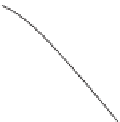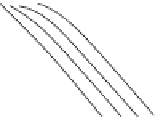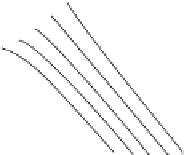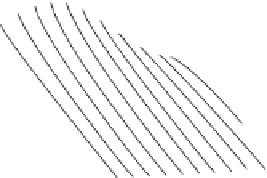Geoscience Reference
In-Depth Information
c
=
gh
2
0
-2
-4
0
-1
-2
y
/
R
-3
6
4
-4
2
0
-2
-4
-6
kx
Figure 3.12
Schematic representation of a Kelvin wave travelling parallel to a vertical land
boundary located along the axis y
¼
0. Note that, in this southern hemisphere case, the land
is to the left of the direction of wave propagation. The amplitude of the waves decreases
exponentially away from the boundary on a length scale set by the Rossby radius Ro so that
at y
¼
4Ro the wave amplitude is
<
2% of its value along the land boundary.
In the x direction, the dynamical balance remains unchanged from (
3.58
) so the
waves again travel at the phase speed of c
g
p
but we now seek a solution for a
progressive harmonic wave, which varies in y, of the form:
¼
¼
F
ð
y
Þ
sin
ð
kx
ot
Þ
ð
3
:
64
Þ
where F(y) is some function varying in the y direction only. The relation between
u and
remains as in
Equation (3.60)
so that the particle velocity is given by
g
c
¼
g
c
F
u
¼
ð
y
Þ
sin
ð
kx
ot
Þ:
ð
3
:
65
Þ
Using
Equations (3.64)
and
(3.65)
, the geostrophic balance
(Equation 3.63)
in the
y direction then requires that:
@
F
ð
y
Þ
f
c
F
y
¼
ð
y
Þ:
ð
3
:
66
Þ
@
F(y) must then be of the form:
e
fy
=
c
e
y
=
Ro
F
ð
y
Þ¼
¼
ð
3
:
67
Þ
where Ro
c/f is the external Rossby radius which we defined in
Equation (3.51)
during
our discussion of coastal upwelling. The forward travelling wave is now described by:
¼
g
c
A
f
e
y
=
Ro
sin
A
f
e
y
=
Ro
sin
¼
ð
kx
ot
Þ;
u
¼
ð
kx
ot
Þ:
ð
3
:
68
Þ
The resulting shape of this wave is shown in
Fig. 3.12
for the case of the southern
hemisphere. Notice for the southern hemisphere that the wave travels with the coast
to its left. In the northern hemisphere, the wave direction would be reversed. The






























































Search WWH ::

Custom Search